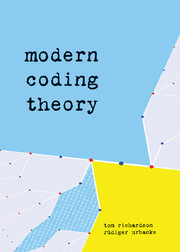Book contents
- Frontmatter
- Contents
- PREFACE
- 1 INTRODUCTION
- 2 FACTOR GRAPHS
- 3 BINARY ERASURE CHANNEL
- 4 BINARY MEMORYLESS SYMMETRIC CHANNELS
- 5 GENERAL CHANNELS
- 6 TURBO CODES
- 7 GENERAL ENSEMBLES
- 8 EXPANDER CODES AND FLIPPING ALGORITHM
- A ENCODING LOW-DENSITY PARITY-CHECK CODES
- B EFFICIENT IMPLEMENTATION OF DENSITY EVOLUTION
- C CONCENTRATION INEQUALITIES
- D FORMAL POWER SUMS
- E CONVEXITY, DEGRADATION, AND STABILITY
- Authors
- Index
5 - GENERAL CHANNELS
Published online by Cambridge University Press: 05 September 2012
- Frontmatter
- Contents
- PREFACE
- 1 INTRODUCTION
- 2 FACTOR GRAPHS
- 3 BINARY ERASURE CHANNEL
- 4 BINARY MEMORYLESS SYMMETRIC CHANNELS
- 5 GENERAL CHANNELS
- 6 TURBO CODES
- 7 GENERAL ENSEMBLES
- 8 EXPANDER CODES AND FLIPPING ALGORITHM
- A ENCODING LOW-DENSITY PARITY-CHECK CODES
- B EFFICIENT IMPLEMENTATION OF DENSITY EVOLUTION
- C CONCENTRATION INEQUALITIES
- D FORMAL POWER SUMS
- E CONVEXITY, DEGRADATION, AND STABILITY
- Authors
- Index
Summary
We now look at a select list of applications beyond the simple model of binary memoryless symmetric channels. We formalize each problem and point out how the system can be analyzed. Rather than discussing applications in their full generality, we limit ourselves to interesting special cases. In the same spirit, we do not present highly tuned solutions but explain how each system can be optimized. This keeps the exposition simple. The generalizations are quite routine. Since the Forney-style factor graph (FSFG) of a large system is the composition of the individual FSFGs of its components, it suffices for the most part to study those components in isolation. Real transmission scenarios typically involve combinations of the various components discussed in the following.
Each example introduces one new ingredient. A simple model of a fading channel is discussed in Section 5.1. We next discuss the prototypical asymmetric channel (the so-called Z channel) in Section 5.2. We then turn in Section 5.3 to an information-theoretic application of factor graphs – computing information rates of channels with memory. We also discuss how to code over channels with memory. In Section 5.4 we see how to construct systems with high spectral efficiency from simple binary ones. Very similar in spirit is the discussion on multiple-access channels in Section 5.5.
- Type
- Chapter
- Information
- Modern Coding Theory , pp. 291 - 322Publisher: Cambridge University PressPrint publication year: 2008

